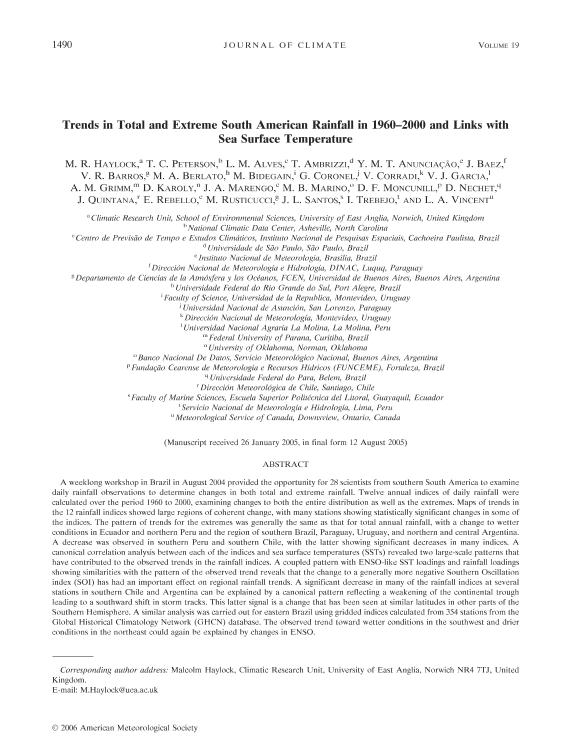Artículo
Trends in total and extreme South American rainfall in 1960-2000 and links with sea surface temperature
Haylock, Malcolm R.; Peterson, T. C.; Alves, L. M.; Ambrizzi, T.; Anunciação, Y. M. T.; Baez, J.; Barros, Vicente Ricardo ; Berlato, M. A.; Bidegain, M.; Coronel, G.; Corradi, V.; Garcia, V. J.; Grimm, A. M.; Karoly, D.; Marengo, José A.; Marino, M.B.; Moncunill, D. F.; Nechet, D.; Quintana, J.; Rebello, E.; Rusticucci, Matilde Monica
; Berlato, M. A.; Bidegain, M.; Coronel, G.; Corradi, V.; Garcia, V. J.; Grimm, A. M.; Karoly, D.; Marengo, José A.; Marino, M.B.; Moncunill, D. F.; Nechet, D.; Quintana, J.; Rebello, E.; Rusticucci, Matilde Monica ; Santos, J. L.; Trebejo, I.; Vincent, L. A.
; Santos, J. L.; Trebejo, I.; Vincent, L. A.
 ; Berlato, M. A.; Bidegain, M.; Coronel, G.; Corradi, V.; Garcia, V. J.; Grimm, A. M.; Karoly, D.; Marengo, José A.; Marino, M.B.; Moncunill, D. F.; Nechet, D.; Quintana, J.; Rebello, E.; Rusticucci, Matilde Monica
; Berlato, M. A.; Bidegain, M.; Coronel, G.; Corradi, V.; Garcia, V. J.; Grimm, A. M.; Karoly, D.; Marengo, José A.; Marino, M.B.; Moncunill, D. F.; Nechet, D.; Quintana, J.; Rebello, E.; Rusticucci, Matilde Monica ; Santos, J. L.; Trebejo, I.; Vincent, L. A.
; Santos, J. L.; Trebejo, I.; Vincent, L. A.
Fecha de publicación:
12/2006
Editorial:
Amer Meteorological Soc
Revista:
Journal Of Climate
ISSN:
0894-8755
Idioma:
Inglés
Tipo de recurso:
Artículo publicado
Clasificación temática:
Resumen
A weeklong workshop in Brazil in August 2004 provided the opportunity for 28 scientists from southern South America to examine daily rainfall observations to determine changes in both total and extreme rainfall. Twelve annual indices of daily rainfall were calculated over the period 1960 to 2000, examining changes to both the entire distribution as well as the extremes. Maps of trends in the 12 rainfall indices showed large regions of coherent change, with many stations showing statistically significant changes in some of the indices. The pattern of trends for the extremes was generally the same as that for total annual rainfall, with a change to wetter conditions in Ecuador and northern Peru and the region of southern Brazil, Paraguay, Uruguay, and northern and central Argentina. A decrease was observed in southern Peru and southern Chile, with the latter showing significant decreases in many indices. A canonical correlation analysis between each of the indices and sea surface temperatures (SSTs) revealed two large-scale patterns that have contributed to the observed trends in the rainfall indices. A coupled pattern with ENSO-like SST loadings and rainfall loadings showing similarities with the pattern of the observed trend reveals that the change to a generally more negative Southern Oscillation index (SOI) has had an important effect on regional rainfall trends. A significant decrease in many of the rainfall indices at several stations in southern Chile and Argentina can be explained by a canonical pattern reflecting a weakening of the continental trough leading to a southward shift in storm tracks. This latter signal is a change that has been seen at similar latitudes in other parts of the Southern Hemisphere. A similar analysis was carried out for eastern Brazil using gridded indices calculated from 354 stations from the Global Historical Climatology Network (GHCN) database. The observed trend toward wetter conditions in the southwest and drier conditions in the northeast could again be explained by changes in ENSO.
Palabras clave:
Sea Surface
,
Extreme
,
South American
,
Rainfall
Archivos asociados
Licencia
Identificadores
Colecciones
Articulos(CIMA)
Articulos de CENTRO DE INVESTIGACIONES DEL MAR Y LA ATMOSFERA
Articulos de CENTRO DE INVESTIGACIONES DEL MAR Y LA ATMOSFERA
Citación
Haylock, Malcolm R.; Peterson, T. C.; Alves, L. M.; Ambrizzi, T.; Anunciação, Y. M. T.; et al.; Trends in total and extreme South American rainfall in 1960-2000 and links with sea surface temperature; Amer Meteorological Soc; Journal Of Climate; 19; 8; 12-2006; 1490-1512
Compartir
Altmétricas



